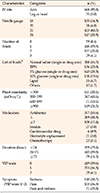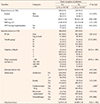Abstract
Purpose
The objective of this study was to identify the risk factors for early symptoms of phlebitis with peripheral intravenous catheters.
Methods
This study involved 226 patients who were admitted to Hallym university Kangnam sacred heart hospital in Seoul. The analysis included 703 intravenous lines. Basic information was extracted from Electronic Medical Records (EMRs) primarily, and the detailed information was collected by reviewing the EMRs from September 21 in 2017 to October 31 in 2017. Data were analyzed using descriptive statistics, independent t-test, χ2 test, and mixed effect logistic regression.
Results
Of the intravenous lines, 4.1% involved early stage of phlebitis, and 36.3% involved early symptoms of phlebitis. Gender, needle gauge size and osmolarity of fluids were significant factors for early symptoms of phlebitis.
Conclusion
To prevent serious phlebitis, rapid detection and intervention of early symptoms of phlebitis are needed. As multiple factors, including patient factors and intravenous infection factors, contribute to the development of phlebitis, a protocol should be developed to prevent infusionrelated phlebitis considering various risk factors.
Figures and Tables
References
1. Tagalakis V, Kahn SR, Libman M, Blostein M. The epidemiology of peripheral vein infusion thrombophlebitis: a critical review. The American Journal of Medicine. 2002; 113(2):146–151. DOI: 10.1016/S0002-9343(02)01163-4.


2. Nassaji-Zavareh M, Ghorbani R. Peripheral intravenous catheter-related phlebitis and related risk factors. Singapore Medical Journal. 2007; 48(8):733–736.

3. Dychter SS, Gold DA, Carson D, Haller M. Intravenous therapy: a review of complications and economic considerations of peripheral access. Journal of Infusion Nursing. 2012; 35(2):84–91. DOI: 10.1097/NAN.0b013e31824237ce.

4. Choi JS, Park ES, Jin HY, Jung SY, Park MR, Kim JE, et al. Focused on 6 hospitals in Seoul or Gyonggi-do, Korea: epidemiologic study of phlebitis associated with short-term intravenous catheter. Korean Journal of Nosocomial Infection Control. 2003; 8(2):95–102.
5. Yoon HS, Park MA, Park EJ, Choi JH, Kim MY, Lim JM, et al. Study on prolonging peripheral intravenous catheter indwell time based on phlebitis rate. Journal of Korean Clinical Nursing Research. 2010; 16(1):145–153.
6. Choi JH, Kang MJ, Park YH, Hong BR, Lee DS. The development of phlebitis in relation to 18 gauge peripheral intravenous catheter dwell time among surgical patients. Journal of Korean Clinical Nursing Research. 2015; 21(2):188–195.
7. da Silva GA, Priebe S, Dias FN. Benefits of establishing an intravenous team and the standardization of peripheral intravenous catheters. Journal of Infusion Nursing. 2010; 33(3):156–160. DOI: 10.1097/NAN.0b013e3181d9c942.

8. Zingg W, Pittet D. Peripheral venous catheters: an under-evaluated problem. International Journal of Antimicrobial Agents. 2009; 34:suppl 4. S38–S42. DOI: 10.1016/S0924-8579(09)70565-5.

9. Centers for Disease Control and Prevention. Guidelines for the prevention of intravascular catheter-related infections [Internet]. Atlanta: Centers for Disease Control and Prevention;2011. cited 2019 January 29. Available from: https://www.cdc.gov/infectioncontrol/guidelines/bsi/recommendations.html.
10. Bolton D. Improving peripheral cannulation practice at an NHS Trust. British Journal of Nursing. 2010; 19(21):1346–1350. DOI: 10.12968/bjon.2010.19.21.79998.

11. Rickard CM, Webster J, Wallis MC, Marsh N, McGrail MR, French V, et al. Routine versus clinically indicated replacement of peripheral intravenous catheters: a randomised controlled equivalence trial. The Lancet. 2012; 380(9847):1066–1074. DOI: 10.1016/S0140-6736(12)61082-4.

12. Tuffaha HW, Rickard CM, Webster J, Marsh N, Gordon L, Wallis M, et al. Cost-effectiveness analysis of clinically indicated versus routine replacement of peripheral intravenous catheters. Applied Health Economics and Health Policy. 2014; 12(1):51–58. DOI: 10.1007/s40258-013-0077-2.


13. Webster J, Osborne S, Rickard CM, New K. Clinically-indicated replacement versus routine replacement of peripheral venous catheters. Cochrane Database of Systematic Reviews. 2015; (8):CD007798. DOI: 10.1007/s40258-013-0077-2.

14. Tan YHG, Tai WLS, Sim C, Ng HLI. Optimising peripheral venous catheter usage in the general inpatient ward: a prospective observational study. Journal of Clinical Nursing. 2017; 26(1-2):133–139. DOI: 10.1111/jocn.13451.


15. van der Sar-van der Brugge S, Posthuma EFM. Peripheral intravenous catheter-related phlebitis. Nederlands Tijdschrift voor Geneeskunde. 2011; 155:A3548.
16. Leenders NHJ, Oosterheert JJ, Ekkelenkamp MB, De Lange DW, Hoepelman AIM, Peters EJG. Candidemic complications in patients with intravascular catheters colonized with Candida species: an indication for preemptive antifungal therapy. International Journal of Infectious Diseases. 2011; 15(7):e453–e458. DOI: 10.1016/j.ijid.2011.03.009.

17. Singh R, Bhandary S, Pun KD. Peripheral intravenous catheter related phlebitis and its contributing factors among adult population at KU Teaching Hospital. Kathmandu University Medical Journal. 2008; 6(24):443–447. DOI: 10.3126/kumj.v6i4.1732.

18. Maki DG, Ringer M. Risk factors for infusion-related phlebitis with small peripheral venous catheters: a randomized controlled trial. Annals of Internal Medicine. 1991; 114(10):845–854. DOI: 10.7326/0003-4819-114-10-845.

19. Lanbeck P, Odenholt I, Paulsen O. Antibiotics differ in their tendency to cause infusion phlebitis: a prospective observational study. Scandinavian Journal of Infectious Diseases. 2002; 34(7):512–519. DOI: 10.1080/00365540110080908.


20. Gorski LA, Hagle ME, Bierman S. Intermittently delivered IV medication and pH: reevaluating the evidence. Journal of Infusion Nursing. 2015; 38(1):27–46. DOI: 10.1097/NAN.0000000000000081.

21. World Health Organization. Body mass index - BMI [Internet]. Geneve: World Health Organization;2018. cited 2019 January 29. Available from: http://www.euro.who.int/en/health-topics/disease-prevention/nutrition/a-healthy-lifestyle/body-mass-index-bmi.
22. Jackson A. Infection control-a battle in vein: infusion phlebitis. Nursing Times. 1998; 94(4):68–71.
23. Higginson R, Parry A. Phlebitis: treatment, care and prevention. Nursing Times. 2011; 107(36):18–21.
24. Gallant P, Schultz AA. Evaluation of a visual infusion phlebitis scale for determining appropriate discontinuation of peripheral intravenous catheters. Journal of Infusion Nursing. 2006; 29(6):338–345.


25. Hedeker D. A mixed-effects multinomial logistic regression model. Statistics in Medicine. 2003; 22(9):1433–1446. DOI: 10.1002/sim.1522.


26. Cicolini G, Manzoli L, Simonetti V, Flacco ME, Comparcini D, Capasso L, et al. Phlebitis risk varies by peripheral venous catheter site and increases after 96 hours: a large multi-centre prospective study. Journal of Advanced Nursing. 2014; 70(11):2539–2549. DOI: 10.1111/jan.12403.

27. Alexandrou E, Ray-Barruel G, Carr PJ, Frost SA, Inwood S, Higgins N, et al. Use of short peripheral intravenous catheters: characteristics, management, and outcomes worldwide. Journal of Hospital Medicine. 2018; 13(5):E1–E7. DOI: 10.12788/jhm.3039.

28. Castillo MI, Larsen E, Cooke M, Marsh NM, Wallis MC, Finucane J, et al. Integrated versus non-integrated peripheral intravenous catheter. Which is the most effective system for peripheral intravenous catheter management? (The OPTIMUM study): a randomised controlled trial protocol. BMJ Open. 2018; 8(5):e019916. DOI: 10.1136/bmjopen-2017-019916.

29. Cho SH, Lee JY, June KJ, Kim Y. Nurse staffing levels and proportion of hospitals and clinics meeting the legal standard for nurse staffing for 1996-2013. Journal of Korean Academy of Nursing Administration. 2016; 22(3):209–219. DOI: 10.11111/jkana.2016.22.3.209.

30. Whitson M1. Intravenous therapy in the older adult: special needs and considerations. Journal of Infusion Nursing. 1996; 19(5):251–255.
31. Boullata JI, Gilbert K, Sacks G, Labossiere RJ, Crill C, Goday P, et al. A.S.P.E.N. clinical guidelines: parenteral nutrition ordering, order review, compounding, labeling, and dispensing. Journal of Parenteral and Enteral Nutrition. 2014; 38(3):334–377. DOI: 10.1177/0148607114521833.

32. Park JY, Kim HL. A comprehensive review of clinical nurse specialist-led peripherally inserted central catheter placement in Korea: 4101 cases in a tertiary hospital. Journal of Infusion Nursing. 2015; 38(2):122–128. DOI: 10.1097/NAN.0000000000000093.

33. Abedin S, Kapoor G. Peripherally inserted central venous catheters are a good option for prolonged venous access in children with cancer. Pediatric Blood & Cancer. 2008; 51(2):251–255. DOI: 10.1002/pbc.21344.


34. Schwengel DA, McGready J, Berenholtz SM, Kozlowski LJ, Nichols DG, Yaster M. Peripherally inserted central catheters: a randomized, controlled, prospective trial in pediatric surgical patients. Anesthesia & Analgesia. 2004; 99(4):1038–1043. DOI: 10.1213/01.ANE.0000132547.39180.88.






 PDF
PDF ePub
ePub Citation
Citation Print
Print







 XML Download
XML Download